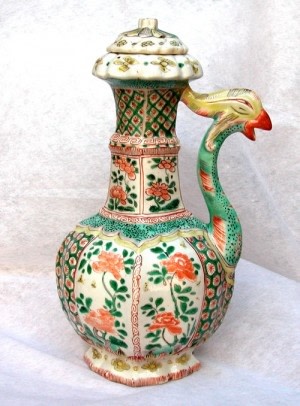Of octagonal section, with a bulbous body divided into lobed panels, continuing on a slanting shoulder, the neck in two-tiers finishes in a flaring mouth with an inverted rim, the long and curved spout shaped as a phoenix neck and head, the ewer standing on a splayed foot, the cover moulded, the body painted in over glaze enamels with four panels of flowering branches issuing from stylised rockwork, small yellow insects buzzing around, and four panels of green honeycomb pattern, each comb with a stylised iron red flower-head, around the shoulder a moulded panel outlined in yellow and grey with a band of black speckled work on a green background finishing around the beginning of the neck with a further moulded band of iron red curl work, around the lower tier of the neck four panels outlined in iron red again with flowering branches issuing from the ground below moulded bands of iron red lines, green dots and iron red meanders, on the top tier four panels of flowered diamond work in green and iron red, finishing with a border of black speckled work on green ground, around the inverted rim yellow stylised flower-heads alternating with green dots, the spout painted on the phoenix's neck in green with black speckled work, red dots and stylised iron red and black feathers, around the base of the neck a ju-i shaped band in grey and yellow and finishing with a yellow tassel, the head painted in yellow with moulded eyes outlined in iron red and stylised feathers in iron red and black, the open beak in deep iron red, the cover with different moulded layers, the centre moulded as an open flower with alternating yellow and grey petals with the exception of one petal which is painted in green, the knop shaped as a small flower head and painted in iron red, all above a basal frieze on the splayed foot of stylised iron red and yellow lotus leaves above yellow flower-heads and a narrow band of iron red lines, the base glazed.
Literature
For an almost identical one but without cover see Christiaan J.A. Jorg in collaboration with Jan van Campen, Chinese Ceramics in the Collection of the Rijksmuseum, Amsterdam, published by Phillip Wilson and the Rijksmuseum Amsterdam, London and Amsterdam, 1997, p. 177, pl 162, where Jorg discusses this type of ewer and we quote; 'this is a good example of a well-known but rarely illustrated type of ewer, which is in fact a variety of the kendi. It enjoyed popularity in Europe as an exotic and decorative piece and, as here, usually came in pairs. The spout is shaped like a feng-huang, which is normally translated as 'phoenix', although this Chinese mythological bird is quite different from the Western phoenix. It is the ruler of all feathered creatures and has many connotations, among them those of the female principle and sexuality. Similar pieces are also known in underglaze blue'.
It is possible that the unusual phoenix form originally derived from 17th Century kendis, as suggested by an unusual Longqing mark and period phoenix-shaped ewer in Jakarta which bears distinct similarities to the one here. See, A. Ridho, Oriental Ceramics, The World's Great Collections, Museum Pusat, Jakarta, Japan, 1982, fig. 219.

